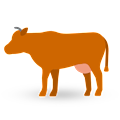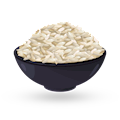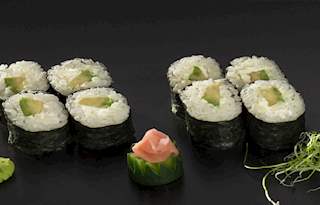Donburi
(丼, Domburi, Japanese Rice Bowl)
Donburi is both a large and deep bowl made of clay, ceramic, or wood that has a lid on, and a dish - rice with a topping that goes inside this bowl. In modern Japan, even a lunchbox containing this type of meal is considered to be donburi.
According to some documents, it is a Japanese concept dating back to the 17th century when it was made with eel and eaten at the theatre. Soon, it became very popular because it was a meal that was easily prepared, yet nutritious and tasty. Today, donburi can be made with absolutely any topping, although it is usually prepared with various vegetables, eggs, meat (beef, pork, or chicken), soy, dashi, and mirin.
It is one of the first original fast foods in Japan and a new restaurant selling donburi is opened almost every day. Donburi dish can be recognized on the menus due to the addition of the word or suffix -don to the name. For example, katsudon is a pork cutlet on rice, and oyako don is rice with egg and chicken as toppings.
Types of Donburi
Recipe variations
Classic Gyūdon
READY IN 25minThe following recipe shows a classic approach to gyūdon, in which the beef is simmered in soy sauce, sake, mirin, and sugar with some onion and ginger, a type of preparation typical for the Kantō region.
Simple Gyūdon
READY IN 20minThe following recipe shows how to prepare a pan-fried gyūdon braised in sake, mirin, and soy sauce and served with rice and fresh cabbage. Having the meat fried first is typical for the Kansai region.
Simple Oyakodon
READY IN 20minThe following recipe gives simple directions on how to make a classic Japanese oyakodon, plus a few extra tips. For example, choosing chicken thighs will provide more flavor to the dish, although the breast will work just fine. To upgrade the dish one can add shiitake mushrooms, green beans or edamame, or use shredded nori algae for garnishing.
Basic Oyakodon with Homemade Dashi
READY IN 20minHomemade dashi — fish stock used for numerous Japanese dishes — is the key ingredient for this oyakodon recipe, adapted from japanesecooking101.com. Luckily, both the dashi and the oyakodon are simple to make. The amounts in this recipe are adjusted to serve one person, but can easily be multiplied, in which case the oyakodon can be prepared in a single, large pan.
Tanindon
READY IN 20minThe word tanin means a stranger or an unrelated person in Japanese, so this version of oyakodon uses beef or pork instead of chicken. The recipe was adapted from Hirokoliston.com, and the preparation technique is almost identical to the one used for the oyakodon.
Salmon Oyakodon
READY IN 5minThis recipe changes the roles a little bit; instead of chicken eggs and meat, salmon roe and meat is used to create a tasty, seafood version of oyakodon. The recipe was adapted from goodfood.com.au, and suggest eating the fish raw — no cooking needed!
Classic Tendon
READY IN 30minKing prawns, aubergine, renkon lotus root, and mushrooms are the main tempura ingredients of this tendon recipe, adapted from japancentre.com, the website and online store of Japan Center, the Japanese food hall in operation since 1976, located in London. It suggests making the batter only with specialized tempura flour and ice-cold water, which makes the tempura extra light and crispy.
Simple Tendon
READY IN 30minThis recipe was adapted from the book Donburi: Delightful Japanese Meals in a Bowl by Aki Watanabe, a professional chef and cooking and baking instructor. King prawns, shiitake mushrooms, aromatic shiso leaves, and Japanese aubergine are deep-fried once dipped in tempura batter made with egg yolks, baking soda, and all-purpose flour, which is easier to find than the specialized tempura flour. The dish is topped with dark, flavorful sauce and will serve as a light but filling meal for two people.
Tendon with Shrimp, Sweet Potato, Maitake Mushrooms, Asparagus and Eggplant
READY IN 35minThis recipe was adapted from a popular Japanese YouTube channel Cooking With Dog, with over 1,6 million subscribers. The tempura includes shrimp and various vegetables deep-fried in a simple tempura batter, which are then served over a bowl of rice and drizzled with tempura sauce.
Unadon
READY IN 15minThe following recipe shows how to prepare unadon the traditional way. The preparation is short because pre-grilled eel fillets are used. There are several options on how to prepare the dish, based on desire and what equipment one has — in a broiler, in the oven, or in the pan on the stove. The recipe is courtesy of Namiko Hirasawa Chen from the Just One Cookbook website, a one-stop shop for every home cook who wants to create authentic and modern Japanese meals.
Donburi Authentic recipe
The following recipe shows a classic approach to gyūdon, in which the beef is simmered in soy sauce, sake, mirin, and sugar with some onion and ginger, a type of preparation typical for the Kantō region.

























